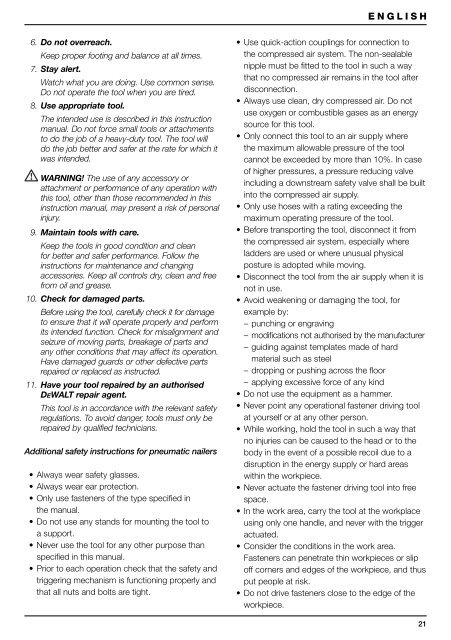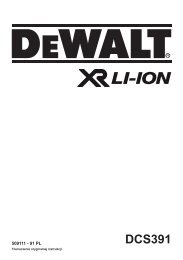XXX man nailer D51238 Euro.indd - Service - DeWalt
XXX man nailer D51238 Euro.indd - Service - DeWalt
XXX man nailer D51238 Euro.indd - Service - DeWalt
You also want an ePaper? Increase the reach of your titles
YUMPU automatically turns print PDFs into web optimized ePapers that Google loves.
6. Do not overreach.<br />
Keep proper footing and balance at all times.<br />
7. Stay alert.<br />
Watch what you are doing. Use common sense.<br />
Do not operate the tool when you are tired.<br />
8. Use appropriate tool.<br />
The intended use is described in this instruction<br />
<strong>man</strong>ual. Do not force small tools or attachments<br />
to do the job of a heavy-duty tool. The tool will<br />
do the job better and safer at the rate for which it<br />
was intended.<br />
WARNING! The use of any accessory or<br />
attachment or perfor<strong>man</strong>ce of any operation with<br />
this tool, other than those recommended in this<br />
instruction <strong>man</strong>ual, may present a risk of personal<br />
injury.<br />
9. Maintain tools with care.<br />
Keep the tools in good condition and clean<br />
for better and safer perfor<strong>man</strong>ce. Follow the<br />
instructions for maintenance and changing<br />
accessories. Keep all controls dry, clean and free<br />
from oil and grease.<br />
10. Check for damaged parts.<br />
Before using the tool, carefully check it for damage<br />
to ensure that it will operate properly and perform<br />
its intended function. Check for misalignment and<br />
seizure of moving parts, breakage of parts and<br />
any other conditions that may affect its operation.<br />
Have damaged guards or other defective parts<br />
repaired or replaced as instructed.<br />
11. Have your tool repaired by an authorised<br />
DEWALT repair agent.<br />
This tool is in accordance with the relevant safety<br />
regulations. To avoid danger, tools must only be<br />
repaired by qualified technicians.<br />
Additional safety instructions for pneumatic <strong>nailer</strong>s<br />
• Always wear safety glasses.<br />
• Always wear ear protection.<br />
• Only use fasteners of the type specifi ed in<br />
the <strong>man</strong>ual.<br />
• Do not use any stands for mounting the tool to<br />
a support.<br />
• Never use the tool for any other purpose than<br />
specifi ed in this <strong>man</strong>ual.<br />
• Prior to each operation check that the safety and<br />
triggering mechanism is functioning properly and<br />
that all nuts and bolts are tight.<br />
ENGLISH<br />
• Use quick-action couplings for connection to<br />
the compressed air system. The non-sealable<br />
nipple must be fi tted to the tool in such a way<br />
that no compressed air remains in the tool after<br />
disconnection.<br />
• Always use clean, dry compressed air. Do not<br />
use oxygen or combustible gases as an energy<br />
source for this tool.<br />
• Only connect this tool to an air supply where<br />
the maximum allowable pressure of the tool<br />
cannot be exceeded by more than 10%. In case<br />
of higher pressures, a pressure reducing valve<br />
including a downstream safety valve shall be built<br />
into the compressed air supply.<br />
• Only use hoses with a rating exceeding the<br />
maximum operating pressure of the tool.<br />
• Before transporting the tool, disconnect it from<br />
the compressed air system, especially where<br />
ladders are used or where unusual physical<br />
posture is adopted while moving.<br />
• Disconnect the tool from the air supply when it is<br />
not in use.<br />
• Avoid weakening or damaging the tool, for<br />
example by:<br />
– punching or engraving<br />
– modifi cations not authorised by the <strong>man</strong>ufacturer<br />
– guiding against templates made of hard<br />
material such as steel<br />
– dropping or pushing across the fl oor<br />
– applying excessive force of any kind<br />
• Do not use the equipment as a hammer.<br />
• Never point any operational fastener driving tool<br />
at yourself or at any other person.<br />
• While working, hold the tool in such a way that<br />
no injuries can be caused to the head or to the<br />
body in the event of a possible recoil due to a<br />
disruption in the energy supply or hard areas<br />
within the workpiece.<br />
• Never actuate the fastener driving tool into free<br />
space.<br />
• In the work area, carry the tool at the workplace<br />
using only one handle, and never with the trigger<br />
actuated.<br />
• Consider the conditions in the work area.<br />
Fasteners can penetrate thin workpieces or slip<br />
off corners and edges of the workpiece, and thus<br />
put people at risk.<br />
• Do not drive fasteners close to the edge of the<br />
workpiece.<br />
21
















